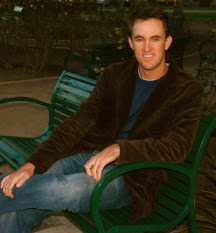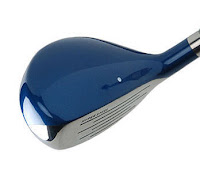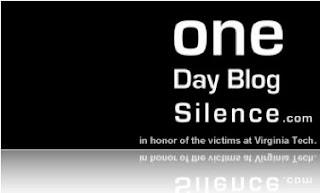The Golfchick
That chick blabbing about anything golf related.
Month: April 2007
Saw this darling bird on Letterman tonight and had to share. He three putted on the show but he didn’t let it get to him. I wish I had his skills!
AJ the parakeet can also dunk a basketball, do gymnastics and bowl – also all better than I can do. Damn bird.
Last week I posted Part One of the Geoff Shackelford interview in which we discussed his golf game and some thoughts on golf course architecture.
 As promised, here is the rest of the interview which covers his writing and some personal topics. For some background, you can check out Geoff’s bio on his website.
As promised, here is the rest of the interview which covers his writing and some personal topics. For some background, you can check out Geoff’s bio on his website.
You’ll notice a couple of times he references the Masters as though it hasn’t happened yet. He actually submitted these responses back to me while I was on a break from blogging, right before the Masters took place.
Once again, Scott Tesar provided a few questions, which are denoted with his initials (ST) in place of my own (KW).
Enjoy!
Geoff Shackelford interview – Part Two
Writing KW: When did your interest in writing begin/how did it develop?GS: I edited my high school paper and have always loved reading the newspaper. Though I rarely opened a book until the age of 20.
KW: Who was the first person who acknowledged your talent and encouraged you?
GS: My parents.
KW: Does the insecurity even end?
GS: Of course not. I can’t stand to read stuff I’ve done that’s more than 2 weeks old.
KW: Clearly you have a creative mind. Have you ever pursued any other ways to express it in addition to architecture and writing?
GS: Well besides my work as a male stripper and my “Def poetry” rants on postmodernism as it relates to the life and work of Leroy Neiman? Oh, sorry. Well, I wrote a couple of movie treatments and a novel, both with some golf in them. Not sure if those count.
KW: Do you write about other subjects than golf and golf architecture?
GS: Nope. I should, but golf has thankfully been keeping me busy and paying the rent.
KW: When and where were you first published? How did it happen?
GS: Riviera Country Club hired me to do a club history in time for the 1995 PGA. That was privately published. After that Masters of the Links was the first actual book bought by a publisher. As for magazine and print stuff, Golfweb on the Internet.
KW: How have your writing pursuits progressed since then?
GS: I wrote and compiled several more books since the early ones. Lately I’ve been doing more blogging and magazine writing, a lot less book writing.
KW: Do you ever write a book without a publishing agreement in place (now that you’re established)?
GS: Every book but Cypress Point and Grounds for Golf has been started without an agreement in place.
KW: When you write a book, what approach do you use (methodical, outline first, type away and edit later, etc.)?
GS: Depends. Most of my books involve several components, so I’ve started with an outline and then it evolves. Sort of like a golf course design: start with some ideas on paper, and then it all goes to hell from there and you hope it comes together at the end.
KW: How much of your time is spent on writing and how much on course design? Is it the ratio you want it to be?
GS: It’s 50-50 right now.
KW: What inspired you to start your website/blog?
GS: I wanted to follow up on the Future of Golf‘s many topics covered related to the health of the sport. So that’s why I continue to blog on the things I do. It all still goes back to that book. Though I would love to have more course design projects to post about! I also started doing it because I think it’s the future of journalism and communications and allows me to share my clipping files online with the rest of the world. Which can be a bad thing when I start getting too snarky.
ST: With the massive amount of content on your site and the frequency of your posts, you seem to post to your blog 24/7. There must be an established income stream to support that. Can you tell us about it?
GS: An established income stream? Did Tim Finchem submit this question? Just kidding. Actually, there isn’t one. It’s what Finchem would call a loss leader. It costs me a small amount per month to maintain thanks to a great host site called Squarespace (that I highly recommend). I don’t have too much bandwidth use because I don’t post a lot of photographs or video, so that keeps the costs down (though I’d like to post more photos and video if available). The site promotes my books and hopefully will be – big MBAspeak word here – a platform to write about and obviously promote my golf course design work as well. I’d like to think it has also helped me get in the door at some magazines I wasn’t writing at before, so it’s paid for itself.
ST: How much time do you spend reading the online world’s resources?
GS: I spend about an hour a day and generally do most of the posts in the evening with a few follow ups the next morning if there’s something I feel like commenting on or a story worth sharing. That might be a lot to some, but as far as looking for material, it’s stuff I was already reading and looking at for ideas because of my other interests in writing. During the majors it’s more than an hour a day, obviously, but that’s where blogging is most fun. I’ll be live blogging from the Masters so that I can make sure to document every silly thing Peter Kostis says.
KW: What are your favorite sources of current golf information, online or otherwise?
GS: Golfobserver.com online and of course in the print world, Golf World, Golf Digest and Sports Illustrated Golf Plus. I don’t get Golfweek anymore. I got tired of their publisher, Jim Nugent, shilling for the manufacturers both in print and behind the scenes. But now that he’s spending more time with his family and pursuing other opportunities at the PGA Tour publishing that bastion of journalism, PGA Tour Partners, I may re-subscribe because they have people like Brad Klein, Scott Hamilton, Adam Schupak, Rex Hoggard and Jim Achenback doing some interesting stuff.
KW: What peeves do you have about blogs/bloggers/blog writing?
GS: Not very entertaining or surprising. I want to be entertained and enlightened. That’s what I hope to do with my stuff.
KW: Can you give any advice to aspiring writers – specifically golf writers? (i.e. What to focus on, what to avoid, how to get published, how to make the transition from self-publishing, what to expect, other helpful hints, etc.)
GS: Don’t expect to make much money in books. I’m not sure about blogging yet, but probably don’t expect it there either. Outside of that, and it’s a cliché, but cliché’s are just truths that everyone gets tired of hearing about: find a “voice.” Even if it’s a pithy, sarcastic voice like mine, it’s me and I’m not pretending to be someone else. It will serve you well in all fields of writing and lets you sleep at night. When I read the golf columnists today in the magazines, there aren’t too many like Dan Jenkins who you can honestly say have an original voice. Bob Verdi, Jaime Diaz and Alan Shipnuck, in the magazine world come to mind (whether you like their work or not), while John Huggan, Lawrence Donegan and Steve Elling are really distinctive voices in the newspaper world. That’s not to say that the many others doing great work in golf are no good because they may not be getting the chance to strut their stuff writing a game story.
Personal
KW: Where is your home base?GS: Santa Monica, CA
KW: How much do you travel?
GS: Not too often. Though I hope that changes with the golf course design work.
KW: Is your office at home or in a separate location?
GS: In the east wing of my mansion.
KW: Are you married, in a relationship, a playa, live alone, co-habitate/Is your – if there is one – significant other in the golf industry or even play golf?
GS: I actually wear a diamond-encrusted necklace that says PLAYA and my mom asked why I was paying tribute to the beach. I had to explain to her what it means to be a playa.
ST: Describe your typical day?
GS: Jeeves wakes me around 8:30 with breakfast in bed along with the L.A. Times, New York Times and the Journal, then we spend the next half hour debating how to bring peace to Darfur and sobriety into Britney’s life. No wait, that’s Bertie Wooster’s life. Sorry.
KW: Why Pepperdine and not UCLA?
GS: I wasn’t good enough coming out of high school to play golf at UCLA, and my grades definitely weren’t good enough!
ST: What is/was it like being Lynn‘s kid? What opportunities did that afford you (i.e. doors opened, contacts made) or did it put up any barriers, challenges or assumptions you had to overcome?
GS: Well once I stopped playing basketball, there were no barriers to overcome. It was great though because I got to travel with him a ton when he was announcing, so I had seen much of the world by the age of 18 and met so many interesting people. And that was when flying was fun.
KW: Do you have any time for other hobbies? If so, what are they?
GS: I try to spend as much time at the beach as possible. I like to work out, read, watch movies and when we aren’t in the middle of a drought, I love hiking in Southern California and taking in our unique environment, especially in spring when the wildflowers and sage scrub look so great. I’ve even started to get into bird watching, something Ben Crenshaw has taught me a little about and which I’ve really grown to appreciate in my old age. I also love music and concerts, and love discovering new artists.
KW: Name one specific thing that makes you smile?
GS: Knowing that Bobby Clampett has been reduced to a fill in announcer for CBS? Oh sorry. Actually with the depressing state of our world, of late The Daily Show, Stephen Colbert and 30 Rock really make me laugh, which, therefore, makes me smile.
KW: What makes you the happiest?
GS: Good food, good wine and laughing with friends about this mad, mad world. Oh, and knowing that the Masters is just about here.
Thanks again to Geoff for his time and effort in answering all these questions and for sharing himself with all of us. I don’t know about you, but I certainly learned some things. Like who knew a male stripper could be so pithy?Next post.
I often find myself saying – either aloud or in my head – “What is WRONG with people?” Sometimes it’s for more serious actions, but I also use it for the stupid little things people do.
Like leaving cigar and cigarette butts all over the golf course. I mean, come on! Presumably, you’ll repair your divots and ball marks in an effort to clean up after yourself and keep the course nice. So what’s the difference? Do you have to be told to pick up your trash as well? Well, if you haven’t yet, here goes…
I hereby dub it official golf etiquette (because I have that power) to keep all golf courses free of your own litter, including butts!
Just remember…
For awhile now I’ve been thinking about trying some graphite shafted irons as part of my experimentation. I know a lot of women use them but I’ve been a steel shaft girl from the beginning. While I’m at it, I should probably get them custom fitted and do it right. At first I didn’t think it was necessary because my swing wasn’t well defined. Now that I’m a little more established, it’s probably time.
I figure if I go with graphite, they should be stiff flex and men’s length, but it’ll be interesting to see what a professional fitter would say. Out of curiosity, I just tried the SmartFit custom club fitting calculator on Golfsmith.com and came up with the following recommendations:
Shaft Model: Mid launch
Shaft Flex: Stiff
Club length: Men’s standard
Lie angle: +1° Upright
Grip size: Men’s + 1/64 Inch
I wonder if the results will be the same when I actually go in and get my swing speed calculated and all that. I should probably go ahead and do it for my current set of steel shafted irons since I’m not quite ready to take the leap on graphite shafts.
While I’m mulling it over, I’d be happy to hear recommendations on makes and models if you feel like sharing.
Geoff Shackelford is one of the most prolific golf bloggers out there. His popular blog is a constant source of informed commentary especially when it comes to history and golf course design. He often posts observations on “MBA speak” and I particularly enjoy his hilarious series IM’ing with the Commissioners. SportsIllustrated.com’s Gary Van Sickle named GeoffShackelford.com one of the 10 “essential” golf websites along with the likes of ErnieEls.com, GolfObserver.com and Golfweek.com.
Even when I disagree with him, I find his opinions intelligent and thought provoking and he elicits some of the most engaging discussions you’ll find in the comments section on a golf blog.
But he’s much more than a blogger. He is a golf course architect and has authored multiple books on the subject and he writes for several online and printed golf publications as well. I personally admire his writing, style and career, and figured if I wanted to know more about him, so might others. When he agreed to participate in my e-interview, I went a little crazy with my quantity of questions. Knowing that my friend Scott Tesar (best friend I never met) was also an admirer of Geoff’s, I even threw in a few questions he wanted answered.* I never expected Geoff to answer as many as he did, and I am truly thankful for all his responses and the time he put into them.
Since there are so many questions, I have broken them down by category and will post them in two parts. This part covers his game and golf course architecture. The second part will cover his writing and some personal tidbits, so stay tuned for that!
*Scott’s questions are indicated with “ST“- mine are “KW“.
Geoff Shackelford interview – Part One
Your game
KW: When did you start playing golf and what were the circumstances?
GS: I tagged along with my dad and granddad when they played Valencia, home to the Champions Tour event. That was back when it was private, and not to sound too old, was surrounded by nothing. You could stand on the 14th tee and see nothing but open fields and farmland. Now there’s a Hyatt, movie theaters and a really neat putting course/restaurant called The Greens.
KW: Was it love at first sight or how did it develop?
GS: It developed slowly, more tagging along and then gradually got more into it as I got older and realized I had no jump shot, nor any ability to jump.
KW: What are your top five courses to play and why?
GS: If I had to pick in one of those desert island kind of ways, it’d be Valley Club of Montecito, St. Andrews, Riviera, Royal Dornoch and Armand Hammer. They’re all fun. In fact, I’ve had more fun golf experiences at Armand Hammer, a $2 pitch and putt in Holmby Hills, than just about anywhere else. My Pepperdine teammates and I used to go there after playing Bel-Air and it was by far more fun than the round at Bel-Air!
KW: What’s your favorite local course (in which you’re not personally invested) and why?
GS: Riviera. Masterful design. Though it’s slipping away quickly. I’m glad I got to enjoy it before Tom Marzolf got his hands on it.
KW: What’s your handicap?
GS: No idea. I rarely play. The last handicap I carried I was around a 2 index, which cost me a lot of money. I’d be thrilled to break 80 today. Bum wrist really took the fun out of it, as does the time it takes to play. Though I’ve had some desire lately. I found a chiropractor who adjusted my wrist and have graphite shafted irons that help.
KW: Lowest round score?
GS: 67 twice at Riviera from the white tees.
KW: Any holes-in-one?
GS: One, at Pismo State Beach par-3 when I was about 15. I also double-eagled No. 1 at Riviera with a 2 iron.
KW: Ever compete?
GS: Tried. Played at Pepperdine where I started for a little while, had a whopping two top-10 finishes in a four year career. Also played various amateur events, U.S. Open and Am qualifyings. Don’t miss it even a bit.
KW: Do you belong to a club?
GS: No. Though I’m sure there are many honorary membership committees reading this and wondering how to reconcile their oversights.
KW: What’s in the bag/do you have a favorite club?
GS: These days, as it’s been since the first Bush administration, it’s my trusty Ben Crenshaw Cleveland putter, an 8802 knock off. I had one I liked better, but it got stolen out of my car along with my other clubs. I am an all Taylor-Made guy now, with graphite shafts in the irons in hopes that it will take some of the pain out of hitting shots in cold weather. Finally got rid of my lousy Titleist irons and driver. What junk. Just kidding Wally!
Golf course architecture
KW: When and how did you first get interested in course design?
GS: Growing up at Riviera and reading George Thomas’s book as a teenager.
KW: Did you/do you have a mentor?
GS: Ben Crenshaw, Dan Proctor and Dave Axland were very kind to me during the Riviera greens reconstruction in 1993. I learned a lot from them and they encouraged me quite a bit. Bill Coore just thought I was some spoiled brat. Now he tolerates me!
KW: How and how quickly did your involvement grow/What was your first big break?
GS: I’ve had many, but I guess the first real break was doing a redo of Sinaloa with Dan and Dave when my dad operated it. I learned a lot. Meeting Gil Hanse was the next one.
KW: What do you consider the single most important aspect of a good design?
GS: Whether it’s fun and interesting.
KW: Are you a consultant now/what is the state of your business?
GS: I’m consulting at a few older clubs looking to restore some of their old style design character, and doing that either on my own or in one very special case, with Gil Hanse. I’m also hopeful that a few new projects with Gil are going to start soon. We have just gotten a job on Vancouver Island in Canada. The Prairie Club in Nebraska is still on the drawing board and inching toward a start date in 2008, and there are a couple of others we’re hopeful about.
KW: Do you/have you done course “makeovers” or do you stick to new course development?
GS: I’m interested in new stuff and restoring great old designs. Makeovers are tough, but I’d be interested if it’s the right project. There surely is no shortage of bad architecture built in the last 20 years in need of help. I’m just amazed how many courses call back the architect who messed up the first time around!
ST: When you first start a new golf course project, what is your first step?
GS: Routing the course. It sets the stage for everything else in the planning process. It’s all about routing. And that’s the most fun too. Trying to solve all the issues and walking the land, discovering great land forms or interesting quirks in the landscape that you want to build around.
KW: Do you have particular grasses and sands you prefer to use and do they vary based on region and climate?
GS: Varies. But as a lover of links golf and rugged looking courses, fescue grasses are my favorites. I can only imagine what Rustic Canyon would look like with more fescues and less rye. With sand, anything but the blinding white stuff.
KW: When you design a course, do you base playability on the average player or professionals?
GS: Both. I tend to be overly concerned with the average player since they’re the ones who ultimately make or break the course. But the design concepts for a hole start with figuring out a strategy for the good player, then placing tees, bunkers, greens based on that.
ST: What steps do you follow when designing the layout? What is your strategy/thought process for challenging the golfer?
GS: I’m interested in what is going to make them think. What is going to make them stand on the tee and want to place a shot on a certain side of a fairway based on the green design and day’s hole placement. It’s sad how rarely this occurs in golf course design. Yet most of the great holes have some meaning where the player has to take factors like hole location and hazards into account before teeing off.
KW: A lot of the newer courses that are built to challenge the longer hitters and their new equipment have plenty of room for a couple sets of forward tees yet it seems strategies and playability from there are barely considered. How much consideration do you put into how a course will play from the forward tees?
GS: A lot. It’s so tricky now with such a divide between long and average players. And then of course most golfers look at certain numbers on a card to determine the quality of the course, and that usually is just a number with little meaning about what the design has to offer. But you have to address it or else people will write off a course if it doesn’t meet certain “standards.”
KW: Do you see course design mentality starting to reflect the influx of female players?
GS: A little. Alice Dye’s formula for forward tees is really getting used a lot and has helped get some better forward tees in place. But we have a long way to go.
KW: Do you ever consult with/work with female designers when developing a course?
GS: Never have. I’ve talked with Amy Alcott a fair amount about design. But other than her, I’ve met very few women who have even the slightest bit of interest in golf course design. Why that is, I have no idea.
KW: What’s your biggest peeve about modern golf courses? Any peeves with the classics?
GS: With modern courses, they’re boring, overbuilt, ugly, drain poorly and little thought is put into the actual placement of hazards. Classics? Not really. They did some amazing things with horses and road scrapers!
To be continued…
And that concludes part one of the interview. Geoff really gave some interesting answers and I wish the interview could have been in person so I could have followed up on some of them! Thanks to Scott for for providing some great questions and of course to Geoff for his responses. And again, stay tuned for part two about Geoff’s writing and personal tidbits!
The contents of my bag have been changing lately. Of course, the bag itself has been as well, but I’ll talk about that in a future post. I’m also not talking about the crushed chips & crackers, tees I’ll never use, gadgets I forget about or the orgy of heterogeneous golf balls I have collected from my forays into the weeds to find my originals.
No, this long post is about the guests of honor in the bag – my golf clubs.
Brand and designer names
I have mentioned in several previous posts that I’m a Taylor Made girl. Despite TaylorMade’s apparent lack of interest in my endorsement of their products, I continue to give it. I draw the line at pimping, though, and don’t wear or carry items advertising their logo. Or would that be whoring? Either way, I never saw the point or taste in wearing a designer item with the designer’s name emblazoned on it and why would I do it for golf gear manufacturers? Unless, of course, they paid sponsored me. That being said, I’m still quite happy with my now nearly three-year old set of Taylor Made irons, wedges, fairway woods and driver.
New clubs, golf research
I have TM’s RAC OS Pitching (45 deg) and Sand (55 deg) wedges. Awhile back, I decided to try out some new wedges because so much of my game is played from 100 yards and in and I wondered if carrying a couple more wedges might improve my precision. So I ordered some wedges from GRIP, or Golf Research in Play, which is exactly what I intended to conduct. I went with the Gap wedge (52 deg) – to fill the Gap between the P and W, and the Lob (60 deg) looking for a 75 yard club.

The dilemma that shouldn’t have been
The trouble was, in order to really conduct this research out on a golf course, I’d have to remove two clubs from my bag (following the 14 club rule) in order to carry all four wedges to get a good comparison. Then, to add to my dilemma, GRIP threw a hybrid in the shipment for me to try. Well, I removed my left-handed club without a blink, but to remove two more would be difficult! The hybrid is a 5-H, which should theoretically replace my 5-iron, probably my favorite iron of all. See, the 5-I is my ~160 club, and I find myself in a lot of situations that require that yardage. I wasn’t about to remove it for an untested replacement. I decided to take them all to the range, where the 14-club rule doesn’t matter. I know, I’m such a stickler. Like I couldn’t have just taken them all out and played a few rounds that I didn’t post, right? Or replaced some clubs and played a test round and posted whatever the results were. That score would have been thrown out anyway. Stickler or idiot. You decide. ANYWAY…
Experimenting – the plan
Not that kind of experimenting, you dirty, dirty chipmunks! That’s supposed to be done in college and I skipped that semester. Of course I’m talking about experimenting with new golf clubs.
I was excited to try my new wedges but not so much about the hybrid. (I bought a TM 3H over a year ago and hardly ever use it. I’ve thought about going back to my 3-iron.) For the wedges, my plan was ambitious and was meant to determine exact yardages for each and had something to do with vectors. As for the 5H, I was just going to take a few swings and kind of get a feel for it.
I need to find a better practice range. Tom Barber is a fine establishment and a quick stop on the way from anywhere, just off the road. Plus, I just load up my micro-key with credits, keep in on my key chain so I can just pull up, grab my clubs, pop it in the ball machine and go straight to a station. Trouble is, the stations are all mats. I hate mats. And it’s almost always super windy there so it’s hard to get an accurate read on distance. That and the fact that it’s all downhill. I never said my plan wasn’t faulty.
Funny how things turn around

The GRIP wedges felt okay – at least as good as any iron can feel off a stupid mat. Difficult as it was to judge distance, I went ahead and decided that the 52 degree Gap wedge was too similar to my SW in distance to justify its place in my bag. And I guess I have to face facts – I’m just not that precise. The jury was still out on the 60 degree Lob wedge, and I clearly needed some grass time with it.
What really surprised me was the GRIP 5-Hybrid. I was immediately impressed with its feel. It has a weight and balance that is extremely comfortable – natural, even. Every shot felt pure, even when my execution wasn’t. Still, I felt that way about my TaylorMade 3 rescue at first, too, so I knew to take a wait-and-see attitude with this one.
The real test and the results
 I went ahead and exchanged my 5-iron for the hybrid and the left-handed club for the Lob wedge in my bag for a few rounds. Of course I never had even one 75 yard attempt, let alone several in order to determine if the Lob wedge was the club. I usually use my PW for 100-115 yard shots and my SW for everything inside 100. In order to give the LW a chance, I decided to use it in place of my SW for everything under 75. I think it was all psychological, but I just couldn’t get comfortable with it. I guess I’m just too loyal to my SW.
I went ahead and exchanged my 5-iron for the hybrid and the left-handed club for the Lob wedge in my bag for a few rounds. Of course I never had even one 75 yard attempt, let alone several in order to determine if the Lob wedge was the club. I usually use my PW for 100-115 yard shots and my SW for everything inside 100. In order to give the LW a chance, I decided to use it in place of my SW for everything under 75. I think it was all psychological, but I just couldn’t get comfortable with it. I guess I’m just too loyal to my SW.
The wedges will probably get another shot at a place in my bag, but for now they’re resting quietly. I have to say, they look really sharp. I like the smoke plating (even though I could do without the big white logo on the back) and the sharpness is also literal. The bottom edge is a lot sharper than the edges on my TM wedges, which might be why I couldn’t get comfortable with them right away. The grip feels great and the shafts have a strong, confident feel (I got the men’s clubs because I’m used to playing with steel shafts).
And now the good news
This all took place in January. My first round out with the clubs was in the bitter cold at Los Robles Greens. The new GRIP hybrid made its debut on the #1 handicap 3rd hole. A good drive would have left me with less than 100 yards to the flag, but good drives were scarce that day. So, after a less than great drive, I was in some ugly rough on the right, about 155 from the green which was guarded by a bunker from that angle. In the past, I’d probably have used my 4 iron in that situation because of the rough and the bunker at the end. From the fairway, it would have been 5 iron all the way. I thought it was the perfect opportunity to try the new 5 Hybrid. Blammo. Nailed it clean, sailed over the bunker and ended up about 12 feet from the pin, whereupon I made the birdie putt. That was the beginning of my love affair with this new club that is still going strong.
Robles Greens. The new GRIP hybrid made its debut on the #1 handicap 3rd hole. A good drive would have left me with less than 100 yards to the flag, but good drives were scarce that day. So, after a less than great drive, I was in some ugly rough on the right, about 155 from the green which was guarded by a bunker from that angle. In the past, I’d probably have used my 4 iron in that situation because of the rough and the bunker at the end. From the fairway, it would have been 5 iron all the way. I thought it was the perfect opportunity to try the new 5 Hybrid. Blammo. Nailed it clean, sailed over the bunker and ended up about 12 feet from the pin, whereupon I made the birdie putt. That was the beginning of my love affair with this new club that is still going strong.
 Physically, it’s not exactly my type with its blue color and its bumpy lines, but love isn’t all about looks. Besides, as our relationship matures, I’m even starting to find it attractive. I use it from the rough, I use it from fairways, I use it from fairway bunkers and I’ll use it off the tees on the right par 3’s. After my initial skepticism, it has become my “go-to” club. Yardage-wise, it replaced my 4-iron instead of my 5 (probably because I hit it cleaner more consistently), so my 5 is back in the bag. I keep my 4-iron for low punch shots, but maybe if I get
Physically, it’s not exactly my type with its blue color and its bumpy lines, but love isn’t all about looks. Besides, as our relationship matures, I’m even starting to find it attractive. I use it from the rough, I use it from fairways, I use it from fairway bunkers and I’ll use it off the tees on the right par 3’s. After my initial skepticism, it has become my “go-to” club. Yardage-wise, it replaced my 4-iron instead of my 5 (probably because I hit it cleaner more consistently), so my 5 is back in the bag. I keep my 4-iron for low punch shots, but maybe if I get kinky creative with my 5H, it will handle those, too.
It’s not like this is my first square-dance, either. Many people have great responses the first time they try a hybrid club. I did with my TM 3 rescue but it faded. I guess it’s all in the design of the club. I think maybe that bulgy slot on the bottom – if you’ll pardon my technical jargon – helps keep the club in its groove through the swing no matter the lie and provides the forgiveness that allows me to keep hitting good shots with it more than any other. As for the weights, I’m sure they play a part as well. Maybe I’m supposed to adjust them or something but it seems to be working for me the way it is. Anyway, I don’t need to know how an engine works as long as I like the way the car handles.
Ironically, the amazing forgiveness also concerns me, because I can get sloppy with my swing and not worry about it. The rest of my clubs aren’t that forgiving and I worry that I’ll get sloppy with the rest of my game. Maybe I’ll have to get as many GRIP hybrids as possible!
And to think the whole idea was to get new wedges. Why am I always wookin’ pa nub in all the wrong places?
My latest column is up at worldgolf.com. Well, most of it is.
In light of my recent circumstances and the strong feelings I have about my personalized golf gear, I thought it would be nice to do a column on the personal nature of such items and the impact they can have on a person’s golf game.
I wanted to bolster the article with some thoughts from someone in the business. Since Scott at Tartan Golf Grips provides such comfort items (including my putter grip) and knows a little bit about what they can mean to a golfer, I included a quote from him in my original submission. Worldgolf removed that portion of the article, probably because it was essentially free advertising and they make their living on selling advertising. Can’t blame them, plus I tend to come in over the desired word count anyway. They were also nice enough to retrieve the photo of my gear from my site (I didn’t submit it with the article) and include it in the story, so I give ’em props for that. However, the cut paragraph lended itself to summarizing my thoughts on the topic and segued nicely into my closing sentence.
So if you read it, please mentally insert this blurb in the article right before the closing line:
Scott Tesar, owner of TartanGolfGrips.com, finds it rewarding to provide such a distinctive product that enhances people’s enjoyment of the game on such a personal level. Speaking about his Artan(TM) grip designs and feedback he has received from customers, he says “Many people derive a sense of identity, pride and comfort from their family heritage and history… It’s just basic human nature to enjoy seeing your name and when it’s incorporated into a piece of golf equipment that you use on every hole, and it looks attractive, it creates positive energy and differentiation that contributes to a feeling of confidence on the course.”
© 2024 The Golfchick
Theme by Anders Noren — Up ↑



Commentary on The Masters and a proposed new PGA Tour slogan
These Guys are
GoodPretty GoodBetter than You.Whether it’s all part of the hoax or not, Tiger Woods looked almost human at The Masters.
In fact, Augusta National Golf Club made a bunch of professional golfers look silly this year. The combination of the weather, the rock hard course conditions, insanely slick greens and magnitude of the event made for unprecedented high scores at The Masters this year. The more it gets to you, the more it’ll get to you.
The shot that doesn’t fly as far as you’d expect and spins back into the water starts you thinking.
Now that you’re thinking, you miss a putt by less than an inch and it ends up 10 feet away from the hole which makes you nervous.
Now that you’re nervous, your next tee shot finds the trees and forces you to lay up (if you can get out) and now you’re scared.
Now that you’re scared, you remember where you are and you try too hard instead of just playing your game.
Now that you’ve abandoned your game, you’ll be lucky to shoot even par.
Don’t try to tell me these guys made bad swings, poor decisions and squeaky putts because their skill sets weren’t strong enough. They should be able to adapt to difficult course conditions, formulate sound strategies, club up and calm down. They got rattled on that first demanding day and their mental games failed them.
The strangest thing about it all for me is that every golf writer or blogger I’ve read is complaining that it was no fun to watch! Au contraire!
Now it’s not that I enjoy watching people suffer (not that anyone who gets invited to play at Augusta – in The Masters, no less – should be considered to be suffering at any time) but watching them struggle a bit allowed me to relate a little better to the players.
Of course, if in some parallel universe I actually got to play that course in those conditions from a special set of tees at a reasonable distance even without the added pressure of the event, I’d be lucky to break 100. But the point is, their struggles were recognizable. I am very familiar with punching out from the trees and hitting from drop areas and three putting. I could practically feel myself there doing it.
Unlike Zach Johnson whose dream of playing in The Masters was realistic, most of us will have to settle for watching others do it. Perhaps a realistic dream for mere mortals is to watch them do it in a recognizable fashion.
For me, this tournament was not only not boring, it took entertainment to a new level for golf. Even if my skills could improve enough so I could play more like the pros, this may have been the closest I’ll ever get to playing Augusta.
Next post.